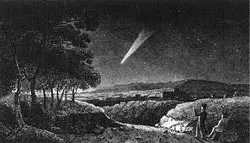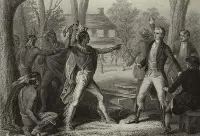The Great Shawnee Leader Tecumseh
Tecumseh was an inspirational Shawnee leader and warrior who strove to limit American encroachments on Native American territory in the early 19th Century. He was born on March 9, 1768, near Chillicothe, Ohio, to a Shawnee war chief, Puckshinwa, and his wife, Methotaske. His name means "Shooting Star"; The young warrior joined a Native American Confederacy under Joseph Brant, a Mohawk chief, that made a habit of interfering with American settlement efforts in the Ohio River Valley. He was part of a united force led by Blue Jacket and Little Turtle that devastated a group of 1,000 American soldiers led by General Arthur St. Clair at the 1791 Battle of the Wabash. In the resulting follow-up, a group of Americans under General "Mad" Anthony Wayne scored a decisive defeat of their own, at the Battle of Fallen Timbers in 1794. Tecumseh survived that defeat, along with a few hundred others, and they formed a new alliance at Prophetstown, which was also known as Tippecanoe. Joining Tecumseh was his brother Tenskwatawa, also known as the Shawnee Prophet. Tecumseh traveled far and wide, in an effort to convince more Native Americans to join his new confederacy. An 1809 treaty gave Americans under William Henry Harrison license to settle on what had been a large amount of land owned by native Americans, and this only added to Tecumseh's urgency. He agreed to meet Harrison at the Council of Vincennes, in 1810, but the two men could brook no agreement. Frustrated, Tecumseh returned to his travels. He went south, as far away as Florida, and met with the Chickasaw, Choctaw, and Creek, imploring them to join what he hoped could become a confederacy that stretched from the Great Lakes to the Gulf of Mexico. The Shawnee leader was away from Tippecanoe when Harrison launched a surprise attack, on Nov. 7, 1811. The Americans were victorious in the Battle of Tippecanoe and burned Prophetstown to the ground. 
Two supranatural events convinced many Native Americans to join Tecumseh's cause. When he was visiting southern tribes in 1811, he predicted that they would see a sign that his cause was a just one. Just as when he was born, his coming was accompanied by a comet streaking across the sky. As well, the New Madrid earthquake of Dec. 16, 1811, shook the continent from coast to coast; many Native Americans interpreted this as the impetus to join Tecumseh's cause.
|
|
Social Studies for Kids
copyright 2002–2024
David White



 he was so named because a comet streaked across the sky as he was born. Tecumseh's father died during the 1774 Battle of Point Pleasant, in Lord Dunmore's War. Tecumseh vowed to fight just like his father. This desire, paired with a natural ability as a public speaker, gave Tecumseh a magnetic personality.
he was so named because a comet streaked across the sky as he was born. Tecumseh's father died during the 1774 Battle of Point Pleasant, in Lord Dunmore's War. Tecumseh vowed to fight just like his father. This desire, paired with a natural ability as a public speaker, gave Tecumseh a magnetic personality. When the
When the 
